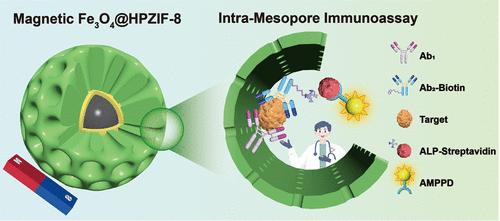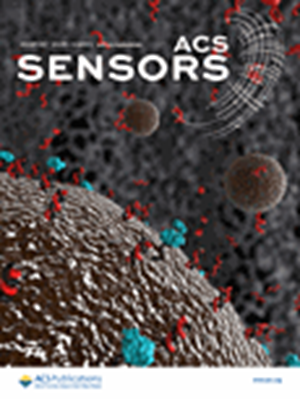Intra-Mesopore Immunoassay Based on Core–Shell Structured Magnetic Hierarchically Porous ZIFs
IF 8.2
1区 化学
Q1 CHEMISTRY, ANALYTICAL
引用次数: 0
Abstract
It is crucial yet challenging to sensitively quantify low-abundance biomarkers in blood for early screening and diagnosis of various diseases. Herein, an analytical model of intra-mesopore immunoassay (IMIA) was proposed, which was competent to examine various biomarkers at the femtomolar level. The success is rooted in the design of an innovative superparamagnetic core–shell structure with Fe3O4 nanoparticles (NPs) at the core and hierarchically porous zeolitic imidazolate frameworks as a shell (Fe3O4@HPZIF-8), achieved through a soft-template directed self-assembly coupled with confinement growth mechanism. Such a unique configuration conceptualized IMIA where the HPZIF-8 shell served as a solid carrier to cover capture antibodies while the Fe3O4 core assisted its rapid separation. The large pore channels not only provided a stable microenvironment to maintain the recognition ability of captured antibodies but also enhanced their coating density, thus promoting the probability of capturing and binding target antigens, significantly improving immunoassay (IA) sensitivity. The practical clinic IA for cTnI (Cardiac Troponin I, biomarker of acute myocardial infarction (AMI)) in human serums was exemplified. The developed IMIA could accurately quantify slight fluctuations in cTnI concentrations in the serums of AMI patients at different stages after symptom onset with more than 100-fold enhancement of limit of detection (LOD) in comparison to conventional plate-based enzyme-linked immunosorbent assay (ELISA). Such high sensitivity of IMIA makes it a powerful tool for the accurate diagnosis of different diseases by altering the type of primary capture antibody.

求助全文
约1分钟内获得全文
求助全文
来源期刊

ACS Sensors
Chemical Engineering-Bioengineering
CiteScore
14.50
自引率
3.40%
发文量
372
期刊介绍:
ACS Sensors is a peer-reviewed research journal that focuses on the dissemination of new and original knowledge in the field of sensor science, particularly those that selectively sense chemical or biological species or processes. The journal covers a broad range of topics, including but not limited to biosensors, chemical sensors, gas sensors, intracellular sensors, single molecule sensors, cell chips, and microfluidic devices. It aims to publish articles that address conceptual advances in sensing technology applicable to various types of analytes or application papers that report on the use of existing sensing concepts in new ways or for new analytes.
 求助内容:
求助内容: 应助结果提醒方式:
应助结果提醒方式:


